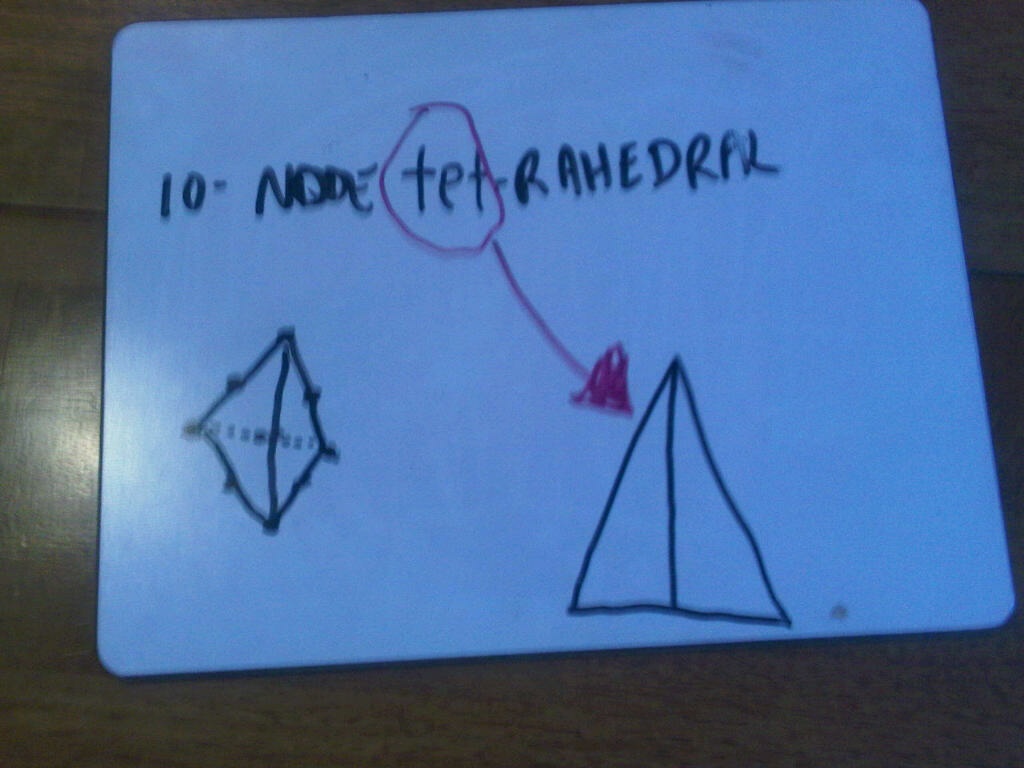Yesterday, my 8-year-old son drew a tetrahedron on his and the word 'tet' and I was intrigued by that. It was simple to be sure but it was a triangular-based period to me. Tetrahedra have a special place in my heart. As a young guy in finite element analysis, for a brief time in the mechanical world and then in electrical, creating a mesh is vital.
In mechanical engineering the maths were a little easier so tool providers worked on making the best mesh and interface tools they could. When I joined a small electromagnetic FEA company named Ansoft they were still losing money 10 years into their existence and part of the problem was that the marketplace was unconvinced you could design something like a chip package or an antenna on a computer.
It may seem odd in 2011 that anyone might claim you can't solve something on a computer but an entire industry built on test benches had a point in 1995; when you are dealing with Maxwell's Equations there is no answer, you just converge on the best answer you can - and in a simulation that means people have to trust the mesh you create to represent the object. Without an accurate representation of a motor, for example, you might get the right answer for an object nothing like the real world object you are designing, even though it is the perfect answer for what you simulated.
In mechanical engineering there were lots of debates about boundary elements or triangular mesh or brick mesh and lots of companies making those the best they could, but in electromagnetics there was really only two camps: time-domain tools, favored by time and voltage people, which used assumptions but had obviously done quite well; and frequency-based tools, which set out to get a 3-D full-wave solution.
Trying to get smart people who were skeptical about the validity of a computer program at all to buy into something new for their design work - when taping out a package for a chip would cost a million bucks - was tough, so when I talked I always talked about the mesh. Everyone already knew Maxwell's Equations, those are fundamental to the entire semiconductor industry(1), so I would just eliminate discussion of the solution and focus on the mesh and highlight that it couldn't replace testing, it would just allow testing to verify a design rather than slow down the iterations. The approach worked, the company went from $6 million a year and in the red to being terrifically profitable and selling for around $800 million to a larger company in the mechanical world. It was a fun 9 years. Like here, scientists (and engineers) were terrifically gracious about making you a little smarter if you wanted to get smarter and I wanted to learn everything about everyone's application so it was like being in an intellectual candy store.
Thus, when my son drew a 'tet' I wanted to give him some intellectual candy too, so I showed him how he could make it look a little more 3-D, dashed lines in the back. Then I showed him how we could put points between the nodes on the four faces and make a 10-node tet, which really boosted the accuracy of your solution but kept the speed because you could interpolate between the nodes. I wrote out how to spell his 'tet' fully so he would know, though I assumed he would forget that part pretty quickly.
Then my 6-year-old walked up and looked at what we were doing and said to his brother, "You spelled 'tent' wrong."

His tet on the right, I circled his shorter spelling. My 10-node on the left with the rest of the word added.
Turns out he had drawn a tent after all. That is, of course, the biggest lesson when trying to help people. Make sure you are solving the problem they really want to solve, otherwise you are just not speaking the same language.
NOTE:
(1) For no reason other than my personal history, we have even a Science 2.0 shirt with Maxwell's Equations on it. I don't think anyone has ever bought one of these except me:






Comments